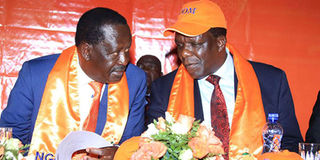Governors back Raila’s three-tier devolution plan

ODM party leader Raila Odinga (leader) confers with his deputy Wycliffe Oparanya during the party's National Governing Council meeting in Nairobi on March 1, 2019. Governors are supporting Mr Raila's power structure revamp scheme. PHOTO | JEFF ANGOTE | NATION MEDIA GROUP
What you need to know:
- The three-tier system means that the country retains the current county and national governments while creating regional governments.
- Siaya Governor Cornel Rasanga also backed the proposal, arguing that counties, as presently constituted, cannot attract serious investments.
Governors have endorsed a proposal for the formation of a three-tier system of government, saying it will strengthen devolution.
Council of Governors (CoG) chairman Wycliffe Oparanya on Tuesday told the Nation they would push for the creation of regional governments.
The idea was first floated by ODM leader Raila Odinga, who argues that some counties are not economically viable.
Mr Odinga, who is pushing for constitutional changes, wants the country to be divided into 14 regions.
The three-tier system means that the country retains the current county and national governments while creating regional governments.
DECENTRALISE
Mr Oparanya, who is also Kakamega governor, denied that his colleagues serving their second term are seeking a soft landing after the 2022 polls.
“Those arguing that we want a soft landing after our terms expire should know that it is not automatic that we will be elected. How sure are you that you will get these seats yet they are elective?” he posed.
The governor added that constitutional changes should be for posterity. “The three-tier system will strengthen devolution because it is not easy for small units like counties to engage a giant one like the national government,” Mr Oparanya said.
“We have devolved many functions but not the financial control,” Mr Oparanya said. “You still have to go to Nairobi to have things done and this will only be addressed by regional governments. We also need to devolve security and we need a bigger unit to deal with those issues.”
INVESTMENT
Mr Oparanya said the regional governments would address the issue of formation of regional blocs.
“We are going for regional blocs because of economies of scale. A small county is not attractive to investors,” the governor said.
Mr Oparanya denied claims that the formation of a three-tier system would lead to bloated governments.
“County assemblies can be reorganised to avoid bloated administrations. They can be changed so that regional assemblies comprise nominees from county assemblies … for example, 10 nominees from county assemblies can be seconded to the regional assembly,” he said.
Siaya Governor Cornel Rasanga also backed the proposal, arguing that counties, as presently constituted, cannot attract serious investments.
“We’ll enjoy economies of scale once regional governments are introduced,” Mr Rasanga said.
REGIONAL BLOCS
On Tuesday, ODM national chairman John Mbadi also supported the proposal, saying “counties are too tiny for serious governance”.
“However, we must clearly define the roles and responsibilities in the proposed structure. We must know services to be provided by the national government and devolve some to regions and counties,” Mr Mbadi said.
He noted that services facing challenges in the counties like health can be given to the regional governments - “which would have a greater capacity to implement them”.
The Suba South MP said regional governments can have agencies, which can create employment and attract investors because of regional economic policies.
Already, counties have formed regional blocs to spur development.





